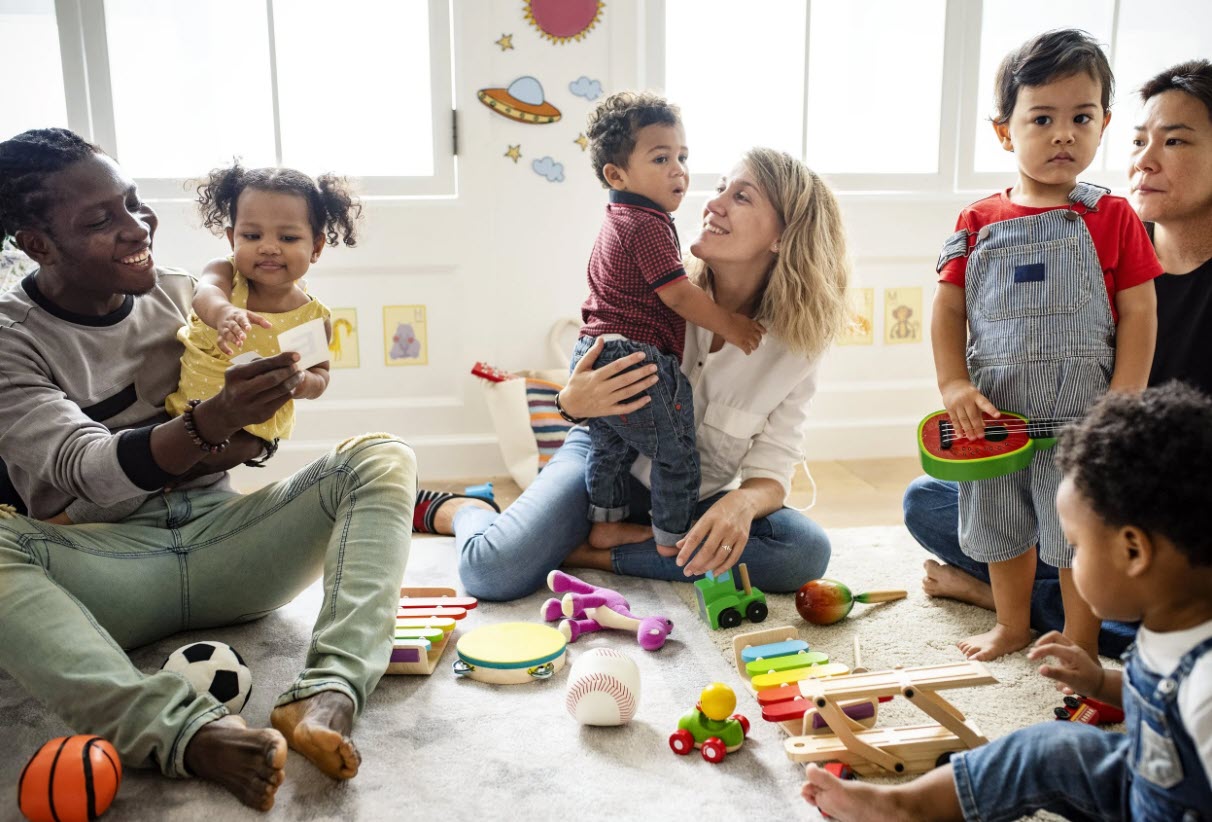As a parent or caregiver, you’re the expert on your child. You notice the first smiles, the coos, the giggles, and the wave “bye-bye.” You’re also the first to spot when something doesn’t feel quite right. This guide—created by the pediatric speech-language pathologists at The Way You Say LLC—explains the key red flags in early communication, what’s “within the range of typical,” and when to seek a professional evaluation. Acting early can make a big difference in your child’s long-term speech, language, and social development.
Quick note: Every child develops at their own pace. Milestones are averages—not hard deadlines. But persistent delays, regressions, or multiple red flags across areas are good reasons to check in with a pediatric SLP.
Why Early Communication Matters
Communication begins long before first words. Babies use eye contact, smiles, cooing, babbling, and gestures to connect. These early skills lay the foundation for vocabulary, sentence building, reading, and social success in school. When we support early communication—especially if there are red flags—children tend to:
- Build bigger vocabularies sooner
- Learn to combine words earlier
- Improve social confidence and behavior
- Thrive during preschool and kindergarten transitions
Early support is not just “nice to have”—it’s protective.
A Quick Tour of Early Milestones (0–4 Years)
Think of these as guideposts—not rigid rules.
- 0–3 months: Quiets to familiar voices, startles to loud sounds, makes eye contact, coos.
- 4–6 months: Laughs, squeals, turns toward sounds, explores pitch, begins babbling (e.g., “ba,” “ga”).
- 7–9 months: Responds to name, looks where you point, enjoys peek-a-boo, babbles with variety (“badaga”).
- 10–12 months: Uses gestures (wave, reach, show), imitates sounds, says first true words (“mama,” “ball”).
- 12–18 months: Understands simple directions (“get the shoe”), shows objects to share, uses 5–20 words.
- 18–24 months: Follows two-step directions with context, uses 50+ words, combines 2 words (“more milk”).
- 2–3 years: Uses short sentences (2–4 words), asks simple questions, 50–75% intelligible to familiar listeners.
- 3–4 years: Tells short stories, asks lots of “why,” 75–100% intelligible to most adults (even strangers).
If your child consistently misses several guideposts or loses skills they once had, it’s time to check in.
Red Flags by Age Range
0–6 Months
- Rarely makes eye contact or social smiles
- Doesn’t startle to loud sounds or calm to your voice
- Limited cooing or vocal play (very quiet baby)
- Very little response to being talked or sung to
6–12 Months
- No babbling (e.g., “ba-ba,” “da-da”) by ~9–10 months
- No response to name by 9–12 months
- Few or no gestures (point, reach, wave) by 12 months
- Little joint attention (doesn’t look where you point)
12–18 Months
- No meaningful single words by 16 months
- Doesn’t imitate sounds or actions (clap, blow kiss)
- Limited understanding of simple directions (“give me the ball”)
- Little interest in communicating needs (points, pulls you, vocalizes)
18–24 Months
- Vocabulary under ~20–30 words by 18 months or under ~50 words by 24 months
- No two-word combinations by 24 months (“more juice,” “daddy up”)
- Limited pretend play (feeding dolls, driving cars, phone play)
- Rarely copies new words after you model them
2–3 Years
- Mostly single words; few word combinations
- Hard to understand more than half the time
- Struggles to follow everyday directions without extra cues
- Minimal sharing, turn-taking, or back-and-forth play
3–4 Years
- Speech is hard for unfamiliar adults to understand most of the time
- Sentences remain short/telegraphic; limited questions or storytelling
- Difficulty playing with peers; limited conversation skills
- Persistent frustration or behavior concerns tied to communication
Red Flags Across Skill Areas
1) Understanding (Receptive Language)
- Doesn’t follow simple directions without heavy gestures
- Doesn’t seem to understand familiar words (names of people, objects)
- Limited response to routines (“bath time,” “put on shoes”)
2) Talking (Expressive Language)
- Very small vocabulary for age
- Rarely imitates new words or sounds
- Few to no two-word combinations by 24 months
3) Speech Sounds (Articulation/Phonology)
- Little babbling (under 12 months) or limited sound variety
- At 2–3 years, speech is frequently hard to understand—even to you
- Persistent drooling or mouth weakness impacting clarity
4) Social Communication (Pragmatics)
- Limited eye contact, smiling, or shared enjoyment
- Rare use of gestures to communicate or “showing” objects
- Little response to social games; prefers to play alone only
5) Play & Feeding (Related Indicators)
- Minimal pretend play by 2 years
- Persistent feeding issues (gagging, extreme selectivity, prolonged bottle)
- Difficulty chewing or transitioning to textures
6) Hearing (Always Rule Out!)
- Frequent ear infections
- Doesn’t respond to environmental sounds or name
- Turns the TV up very loud or relies on visual cues
Regression is urgent. If your child loses words, stops making eye contact, or withdraws after previously engaging—seek an evaluation immediately.
“Late Talker” vs. Language Delay: What’s the Difference?
A late talker may have typical understanding (receptive skills) but a smaller spoken vocabulary. Many late talkers catch up—but not all do. A language delay often includes challenges with both understanding and expression (and sometimes social/play skills). Because it’s hard to predict who will “catch up,” we recommend early evaluation rather than a “wait and see” approach—especially when several red flags are present.
What Parents Can Do Right Now (Evidence-Aligned Tips)
You are your child’s best communication partner. Small, consistent strategies at home make a big difference.
- Follow your child’s lead
Sit face-to-face, watch what interests them, and talk about that. - Narrate and expand
If your child says “ball,” you can say, “Big ball!” or “Throw ball!” - Model, don’t quiz
Provide the word or short phrase repeatedly instead of asking “What’s this?” over and over. - Use gestures + words
Pair pointing, waving, or signs with speech to give multiple cues. - Create communication temptations
Put a favorite toy in a clear container and wait expectantly so your child signals for help. - Offer choices
“Do you want apple or banana?” Pause to let your child attempt a response. - Repeat, repeat, repeat
Kids thrive on repetition: same books, same songs, same routines. - Limit background noise
Keep TV/music low during play to boost attention and listening. - Read with interaction
Point to pictures, label, wait, and let your child turn pages and “help tell” the story. - Check hearing
Even a mild hearing loss can impact language growth—ask your pediatrician for a screen.
These strategies do not replace therapy when it’s needed, but they accelerate progress—before, during, and after formal intervention.
When to Seek a Professional Evaluation
Consider scheduling an evaluation with a pediatric speech-language pathologist if you notice:
- No babbling by 9–10 months
- No gestures by 12 months
- No single words by 16 months
- No two-word phrases by 24 months
- Limited understanding of everyday directions
- Ongoing frustration, behavior challenges tied to communication
- Any loss of skills at any age
You don’t need a diagnosis to get started. An evaluation simply clarifies your child’s strengths and needs and gives you a plan.
What to Expect at an Evaluation with The Way You Say LLC
We make the process playful, warm, and family-centered:
- Conversation & history: We listen to your concerns, medical and developmental history, and daily routines.
- Play-based assessment: Through play, we observe how your child understands language, uses words/gestures, and engages socially.
- Speech-sound screening: We note clarity, sound patterns, and oral-motor skills.
- Hearing referral if needed: We may recommend a hearing check to rule out contributing factors.
- Personalized plan: You’ll leave with clear next steps—home strategies and, if appropriate, a therapy plan tailored to your goals.
- Caregiver coaching: We teach you easy, high-impact techniques to use in everyday moments.
How Therapy Helps (and What It Looks Like)
Pediatric speech therapy is fun and highly individualized. Sessions often include:
- Play-based language building: Modeling words/phrases in activities your child loves
- Gesture/sign/AAC support: When helpful, we add visuals or simple AAC to reduce frustration and increase communication (AAC does not “replace” speech; it often supports it)
- Speech-sound practice: Games to shape clearer sounds and syllables
- Social communication: Turn-taking, joint attention, and early conversation skills
- Caregiver coaching: You’ll learn what to do at home, turning daily routines into language-rich moments
Progress happens fastest when therapy and home practice work hand-in-hand.
Red Flags vs. Myths: Clearing Up Common Confusion
- “Boys just talk later.” Some boys talk later on average, but gender isn’t an explanation for persistent delays.
- “Two languages will confuse my child.” Bilingual exposure does not cause delays. Support both languages.
- “He’ll grow out of it.” Some do—many don’t. Early support is the safest choice.
- “Using signs or pictures will stop speech.” Evidence shows alternative supports often boost verbal development.
- “She’s shy.” Temperament can affect talking, but long-standing delays need attention.
A Handy Mini-Checklist for Parents
If you can check two or more items below, schedule an evaluation:
- ☐ No babbling by 9–10 months
- ☐ No gestures by 12 months
- ☐ No words by 16 months
- ☐ No two-word phrases by 24 months
- ☐ Rarely imitates words or gestures
- ☐ Doesn’t respond consistently to name or simple directions
- ☐ Hard to understand most of the time after age 2½
- ☐ Limited eye contact/joint attention or pretend play
- ☐ Frequent frustration or behavior challenges related to communication
- ☐ Any loss of communication or social skills at any age
FAQs: Early Communication Red Flags
Question: What if my child understands everything but doesn’t talk?
Answer: Strong understanding with limited expression is common in “late talkers,” but not all late talkers catch up. If your child has under ~50 words by 24 months or no two-word phrases, an SLP evaluation is a smart next step.
Question: How do I know if it’s a speech-sound issue or a language delay?
Answer: If your child has many words/ideas but is hard to understand, the challenge may be speech sounds. If your child has few words and limited understanding of directions, language may be the primary area. An evaluation will clarify—many children have both.
Question: Could hearing be the problem even if my child passed the newborn hearing screen?
Answer: Yes. Hearing can change due to ear infections or congestion. If your child doesn’t respond to name or environmental sounds, or turns the TV up high, ask for a current hearing check.
Question: We speak two languages at home. Should we switch to one?
Answer: No. Bilingualism does not cause delays. Continue speaking the languages most natural to your family. We’ll support both.
Question: My child uses a few signs—will that delay speech?
Answer: Signs, pictures, and AAC often reduce frustration and increase overall communication, which can support speech development—not hinder it.
Question: How long does therapy take to “work”?
Answer: It varies. Many families see early progress within weeks as they use strategies at home. Frequency, child engagement, and consistent caregiver coaching all matter.
Question: Do I need a diagnosis to start therapy?
Answer: No. You can seek an SLP evaluation based on developmental concerns alone. If other evaluations (e.g., developmental pediatrics) are indicated, we’ll guide you.
Question: What if my child is shy at the evaluation and won’t talk?
Answer: That’s okay. We use play-based, child-led approaches and gather information from you, observations, and multiple activities to get an accurate picture.
Question: Are red flags the same as autism signs?
Answer: Some red flags overlap (e.g., limited joint attention), but red flags do not equal autism. If broader developmental concerns arise, we’ll recommend appropriate referrals while supporting communication immediately.
Question: Can I start helping before therapy begins?
Answer: Absolutely—use the strategies above (follow your child’s lead, model/expand, offer choices, read interactively). Small daily changes add up.
Ready to Talk It Through?
If you’re noticing red flags—or just have a gut feeling—it’s worth checking in early. The Way You Say LLC offers gentle, playful, evidence-aligned evaluations and therapy that empower both children and caregivers.
Next step: Request an evaluation or a parent consultation at The Way You Say LLC: https://thewayyousayllc.com/
We’re here to help your child find their voice—and to make communication easier, happier, and more fun for your whole family.





